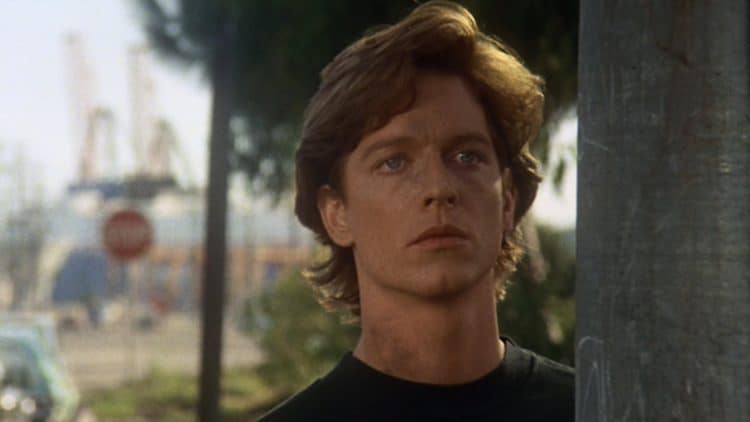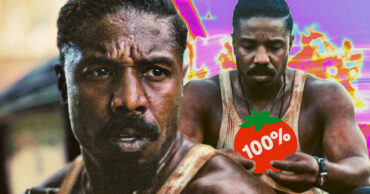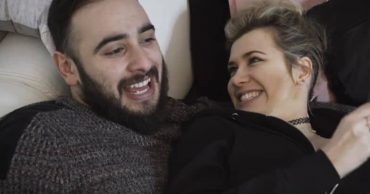
1987 is one of those years in cinema that define everything that was great about the teen romance genre. We saw it again in 1999, and numerous times since then, but this was also the year John Hughes’ Some Kind of Wonderful was released. This movie was not a Brat Pack vehicle and represented the first Hughes teen romance not to feature Molly Ringwald, and perhaps in spite of these box office draws, it became to many at least, the best of the bunch. The film may not have done much to change the winning John Hughes formula of the Ringwald Trilogy (Sixteen Candles, The Breakfast Club, and Pretty in Pink), but the end result felt different from those movies. It felt more like Ferris Bueller’s Day Off in an odd way since even though it was a high school movie, the rigors of cliques and navigating high school were not the central focus. Maybe it was the acting by the cast, the typical comedic moments from Hughes that are always insightful, or perhaps it was that Hughes’s original vision for Pretty in Pink was used for this film (more on this below). Regardless of the reason, Some Kind of Wonderful is the best John Hughes teen movie…depending on the day of the week that is.
It Feels the Most Real
Of all the John Hughes teen-oriented films of the 80s, Some Kind of Wonderful feels the most grounded in reality. Hughes didn’t write the script to service a plot point–like the absurdities a girl faces on her 16th-birthday or how different students from cliques bond–he just told a straightforward love story. To say this is to completely describe the plot of Pretty in Pink, but the character interactions in this movie just ring truer. Eric Stoltz plays a hardworking, outcast named Keith (he likes art, so he must be an outcast right?) who (shocker) happens to have a crush on Amanda Jones (Lea Thompson), the most popular girl in school. She has a prototypical sleazy, popular boyfriend (a delightfully scummy Craig Sheffer), and we just know it’s going to take a down-to-earth, intelligent guy like Keith to change her point of view. Keith’s childhood best friend Watts (a sublime Mary Stuart Masterson) is still at the awkward point of enjoying her tomboy phase, but she of course harbors a torch for Keith–who is, of course, completely oblivious to this. We just know they will end up together by the end of the film.
All of these character insights come to pass, but there is something more urgent and engaging with how the story plays out in this movie. You feel like you truly know these people, whereas the characters in the previous films were caricatures.
It Adds a Satisfying Twist to the Plot
The entire film revolves around Keith’s burgeoning romance with Amanda. Amanda is remote and untouchable at first, but over time, she begins to fall for Keith, and I suppose it doesn’t matter that he completely changes his looks mid-way through the film. We begin to worry that Watts will never get to be with the guy she loves, and then in a surprise twist of circumstance, Keith realizes the error of his ways and gives the earrings to Watts–his “future.” When I first saw the film ages ago, I felt like this wasn’t going to happen, and thankfully, it did. For everyone disappointed with the ending of Pretty in Pink, Some Kind of Wonderful fixed it for you. Truth be told, it would have been perfectly fine had Keith ended up with Amanda, although they didn’t have as much chemistry as Keith and Watts had–some would argue they had more–it also felt right that Keith and Amanda were bonding in all the right ways. But Watts was always the one, and it felt satisfying to see the film end in a way that felt the most realistic. How long would Keith and Amanda have lasted anyway?
All 3 Leads are Truly Superb in Their Roles
Stoltz, Thompson, and Stuart Masterson fully inhabit their respective roles. To be honest, they feel and act more like about-to-be college grads than high school grads, and look the part as well, but a 25-year old playing 17 was certainly the norm in the 1980s. Mary Stuart Masterson makes Watts defiant but engaging; her humor and no-nonsense approach to her character is unforgettable in a sea of forgettable teen performances of that era. Lea Thompson imbues the popular girl with an intriguing amount of pathos that go far beyond making her a one-dimensional stereotype. Her Amanda is strong and intelligent, but is certainly comfortable being the prettiest, most popular girl in the school. This is the first performance I recall ever seeing of Eric Stoltz, and with his filmography now in view, it makes it easier to see how much range and versatility he possessed as an actor in his earlier years.
It’s Everything Pretty in Pink Should Have Been
John Hughes originally wanted Andie (Molly Ringwald) to end up with Duckie (Jon Cryer), but the studio pushed back and demanded that she end up with the popular guy Blane (Andrew McCarthy). It’s almost as if he wrote Some Kind of Wonderful to see that vision through. That is exactly what happened, and it feels so much more realistic in a way. Perhaps Andie did go on a few dates with Blane, and soon realized they had nothing in common. Perhaps Andie and Duckie are happily married to this day. No matter how you feel about the ending of Pretty in Pink, it allowed us to have Some Kind of Wonderful.
The Soundtrack
Last but not least, the movie had an amazing, underrated 80s soundtrack. There were no big name artists like in previous Hughes films, and he allowed many under-the-radar musical artists to have their moment, and the results were well worth it. It’s truly some kind of wonderful to have The March Violets “Turn to the Sky” stuck in your head for days.
 Follow Us
Follow Us





